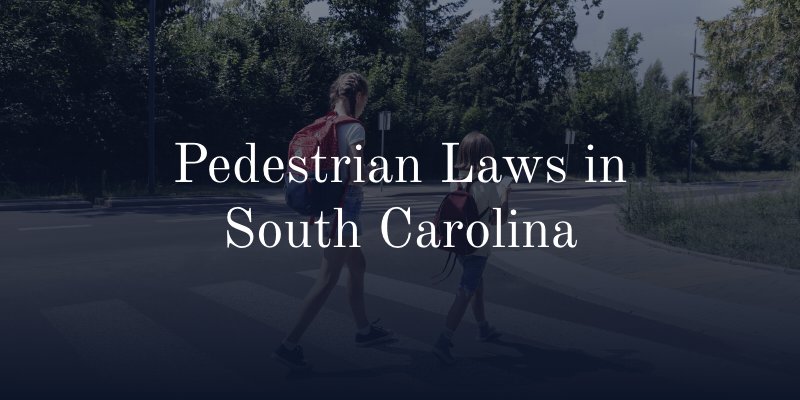Pedestrian Laws in South Carolina
Understanding pedestrian laws in South Carolina is critical, as it promotes your safety and the safety of others around you. When everyone adheres to expected behavior patterns, accidents are less likely to occur. Here are some of the most important pedestrian laws to keep in mind.

Drivers Must Yield to Pedestrians
One significant rule to remember is that drivers must yield to right of way to pedestrians crossing within a crosswalk, especially when there aren’t any traffic control devices present or operating. This obligation ensures your safety while you use assigned crossings.
“(a) When traffic control signals are not in place or not in operation the driver of a vehicle shall yield the right of way, slowing down or stopping if need be to yield to a pedestrian crossing the roadway within a crosswalk when the pedestrian is upon the half of the roadway upon which the vehicle is traveling or when the pedestrian is approaching so closely from the opposite half of the roadway as to be in danger.”
Pedestrians Should Stay on the Right Side
As a pedestrian in South Carolina, it’s vital for your own safety that you follow certain guidelines too. When crossing streets via designated pathways like crosswalks, make sure to stay on the right-hand side whenever it’s possible and safe.
Pedestrians on The Highway
Beyond this, another key regulation insists if there’s an accessible sidewalk beside a roadway, then it becomes unlawful for any pedestrian to choose to walk along the road instead.
In cases where sidewalks are non-existent alongside highways, pedestrians should walk on the shoulder. They must keep as far from the driving lanes as practicably possible.
“(a) Where a sidewalk is provided and its use is practicable, it shall be unlawful for any pedestrian to walk along and upon an adjacent roadway.
(b) Where a sidewalk is not available any pedestrian walking along and upon a highway shall walk only on a shoulder as far as practicable from the edge of the roadway.”
Pedestrians Soliciting Rides and Business
Pedestrians are not permitted to stand in the roadway to solicit rides or business. It’s also unlawful for a person to stand close to roads with the intention of offering services related to watching over or protecting parked vehicles.
“(a) No person shall stand in a roadway for the purpose of soliciting a ride.
(b) Except when authorized by the provisions of Section 5 27 910, no person shall stand on a highway for the purpose of soliciting employment, business, or contributions from the occupant of any vehicle.
(c) No person may stand on or in proximity to a street or highway for the purpose of soliciting the watching or guarding of any vehicle while parked or about to be parked on a street or highway.”
How Your Pedestrian Accident Claim Can Be Impacted If You’re Breaking The Law
If you’re found to be violating a pedestrian law at the time of an accident, your claim can be affected. In South Carolina, which follows a modified comparative negligence system, being partially at fault could decrease the damages awarded in your case.
For example, if you were walking along a roadway while there was a usable sidewalk (which is against pedestrian laws), and get hit by a car, then your actions will likely impact any subsequent claim.
The insurance company – or court if it goes to trial – may hold that you breached the law and were partially responsible for the incident. In these cases, your compensation will be reduced by the percentage they deem you to be responsible. As long as you are less than 51% liable, you can still successfully file a personal injury claim.
Understanding and abiding by pedestrian laws in South Carolina can significantly maximize your personal safety while minimizing legal trouble. However, should you find yourself involved in an accident as a pedestrian or if you have questions about the specific aspects of these laws, it’s crucial to seek professional guidance. If you need help, don’t hesitate to contact us to schedule a free consultation.
